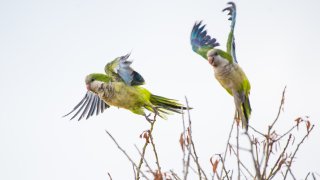
Parrots of the monk parakeet species in the Molfettese countryside near the sea on September 16, 2023 in Molfetta.
With the tropicalization of the climate, an invasion of parrots is occurring in the countryside, which, from their first settlement in Molfetta, have taken over towns and countryside in Bari, Bisceglie, Giovinazzo, Palese, Santo Spirito, Bitonto, Bitetto, Palo del Colle, Binetto, Grumo Appula, and even pushed into the Alta Murgia, Coldiretti Puglia warns.
These are monk parakeets of the species Myiopsitta monachus Boddaert, which appeared with an initial ”settlement” on a eucalyptus tree in the Molfettese contrada ”Madonna delle Rose,” then moved on to settle, building ‘multifamily’ nests and reproducing with great speed.
This species of green parrots, feeds on fruit and especially almonds, with serious damage on production already at an all-time low due to the crazy weather. (Photo by Davide Pischettola/NurPhoto via Getty Images)
Dallas' White Rock Lake gives visitors a chance to experience dozens of species of animals in the middle of a major city. But one species of bird stands out among the rest: the monk parakeet.
It's a bright green bird that is originally from South America. Experts say it's unclear how they wound up in North America, and even harder to pinpoint how they got to Texas specifically.
"There is speculation that in the '60s they came in from for the pet trade. And the story is that they were being shipped in and at John F Kennedy Airport, the crate broke open, birds got released, and that's how they started up in the Northeast," said Liz Tidwell, a wildlife program specialist with the Texas A&M AgriLife Extension Service. "And then from there, we suspect they migrated down here to Texas. The first documented case is actually two parakeets in the early '70s."
Get DFW local news, weather forecasts and entertainment stories to your inbox. Sign up for NBC DFW newsletters.
"Another story is there was supposed to be a shipment to one of our pet stores there around White Rock Lake, and somehow they were released or accidentally got out," said Christopher Morris, an urban biologist with the city of Dallas.
Regardless of how they got here, they're here to stay. Learn how they've adapted to cooler temperatures and a new environment in this week's episode of Texas Wants to Know.